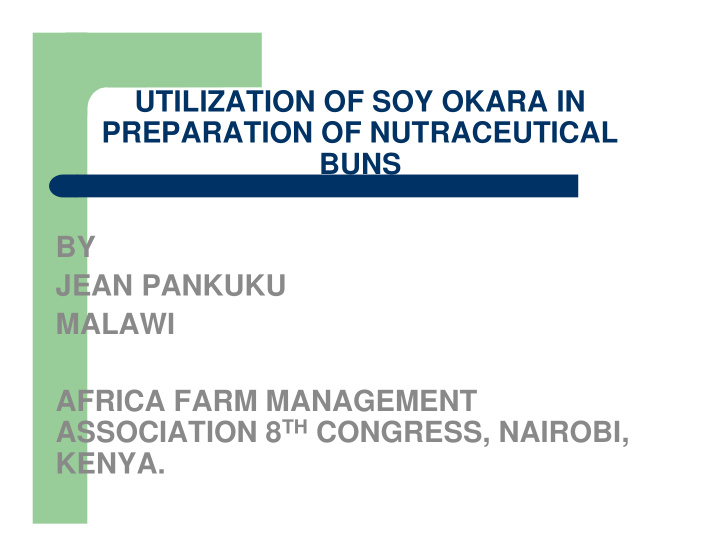



UTILIZATION OF SOY OKARA IN PREPARATION OF NUTRACEUTICAL BUNS BY JEAN PANKUKU MALAWI AFRICA FARM MANAGEMENT ASSOCIATION 8 TH CONGRESS, NAIROBI, KENYA.
Introduction � Malawi and many other African countries depend on maize and other cereals for their staple food. � Apart from maize, root tubers like potatoes and cassava are used in many other parts. � These are basically starchy and do not provide nutritionally balanced meals though eaten in large quantities � The majority of pple in rural areas are therefore at high risk in terms of protein energy malnutrition
Introduction � There is need therefore to include other food stuffs to ensure healthy meals. � Soy bean is an alternative protein source for rural communities � It is utilized in different forms � Soy beans are highly digestible, high in unsaturated FAs & contain no cholesterol. � Soybean & its products are relatively inexpensive protein source as compared to animal sources
Introduction cont’ � A number of initiatives have been done by some NGOs, academic institutions, food industry companies and the govt to promote the use of soy. � Soy okara is a by-product of soy milk processing that is often unutilized or underutilized. � It is not only a rich source of dietary fibre, but also contain high quality protein. � Buns and breads prepared from refined wheat flour are deficient in proteins, vitamins, minerals and fibre, & these need to be replaced.
Aim � To asses the potential of incorporating soy okara in bakery products to improve the nutritional quality. Specific objectives � Effects on sensory quality � Effects on physical properties � Effects on nutritional quality
Materials & Methods � Ingredients for preparation of buns were sourced from local market � Buns were prepared using the standard recipe � Preliminary studies were conducted based on the std recipe to establish %ge of okara supplementation thru sensory evaluation. � Okara was incorporated at 5, 10 & 15% � The sensory attributes were assessed by 15 semi- trained panel on 9-point hedonic scale.
Materials & methods cont… � Physical properties were measured by weighing & measuring scales � Volume was measured using the mustard seed displacement method � The proximate analysis was done using the std methods given by AOAC (1992) � Moisture was analyzed using MBS4 Moisture Analyzer
Results & discussion Sensory analysis Table 1: sensory attributes of okara buns (mean scores) Bun Type CC CCA A TX T CE OA Control 9.00 9.00 8.50 9.00 9.00 8.50 9.00 5% okara 9.00 9.00 8.00 7.00 9.00 7.00 8.00 10% okara 8.20 8.60 7.00 6.00 7.00 6.00 7.50 15% okara 7.50 7.50 6.00 5.00 6.00 5.00 6.00 SEM 0.43 0.16 0.36 0.66 0.32 0.66 0.41 CD at 5% 1.94 0.70 1.61 2.98 1.45 2.98 1.84
Results & discussion cont.. � Buns were accepted at 10% level of supplementation � There was no significant effect on the sensory parameters (colour & appearance, aroma & taste) . � The darker crust colour was due to increased maillard reaction btwn reducing sugars & proteins. � Texture and elasticity mean scores were greatly reduced due to dough weakening caused by a decrease in gluten protein.
Results & discussion cont... � Physical characteristics Table 2: Physical characteristics of okara buns Bun Type Vol (ml) SV (ml/g) Height Area (cm Wt (g) DRC (%) (cm) sq) Control 121.67 2.08 4.70 35.00 58.88 320 5% okara 92.33 1.54 3.90 35.20 51.09 460 10% okara 71.67 1.43 3.70 36.68 51.67 375 15% okara 30.00 0.60 3.07 35.68 51.88 200 SEM 5.27 0.09 0.21 1.04 1.40 CD at 5% 23.71 0.39 0.97 0.97 6.31
Results & discussion cont.. � The physical properties were greatly reduced with increased addition of okara due to dilution of gluten network and increased fibre content. � Buns accepted at 5% in terms of physical characteristics � There was no consistent pattern in weight and area amongst the buns. � Okara flour affected the dough extensibility properties, gas retention properties and bread quality
Results & discussion cont.. � Proximate analysis Table 3: proximate analysis of okara buns (%) Bun Type Carbs Protein Fat Ash MC Fibre EV s (Kcal) Control 62.39 2.04 3.87 1.39 30.28 0.03 292.55 5% okara 62.07 2.34 5.76 1.46 26.07 1.61 308.88 10% okara 59.91 5.91 6.82 1.91 22.05 3.65 314.24 15% okara 58.38 6.79 8.80 2.13 19.08 4.82 339.88 SEM 2.11 0.46 0.39 0.02 0.57 - - CD at 5% 9.50 2.06 1.77 0.10 2.59 - -
Results & discussion cont.. � The results show improvement in proximate composition with the addition of soy okara. � Proteins, fats, fibre and ash were increased. This is attributed to higher protein, fat, fibre and ash of soy beans. � Carbohydrate and moisture contents were reduced. � Energy was increased in okara buns due to increase in fat content
Results & discussion cont.. Nutraceutical content � Incorporation of okara flour increased amount of isoflavones from 0 in control buns to 2.027mg at 15%. � Isoflavones help in treating hypertension, high cholesterol, menopose symptoms, osteoporosis among other diseases.
Conclusion � Soy okara was successfully incorporated in buns � There was significant improvement in nutritional and nutraceutical content on buns. � The high nutritious buns can there4 be prepared by supplementing wheat flour with okara flour. � This is of nutritional importance in developing countries where pple struggle to get proteineous foods.
Recommendations � There is need to create awareness on the incorporation of soy by-products to improve the nutritional & healthy status of pple. � Domestic level processing and utilization of these by-products should be given a priority in rural areas.
THANK YOU
Recommend
More recommend